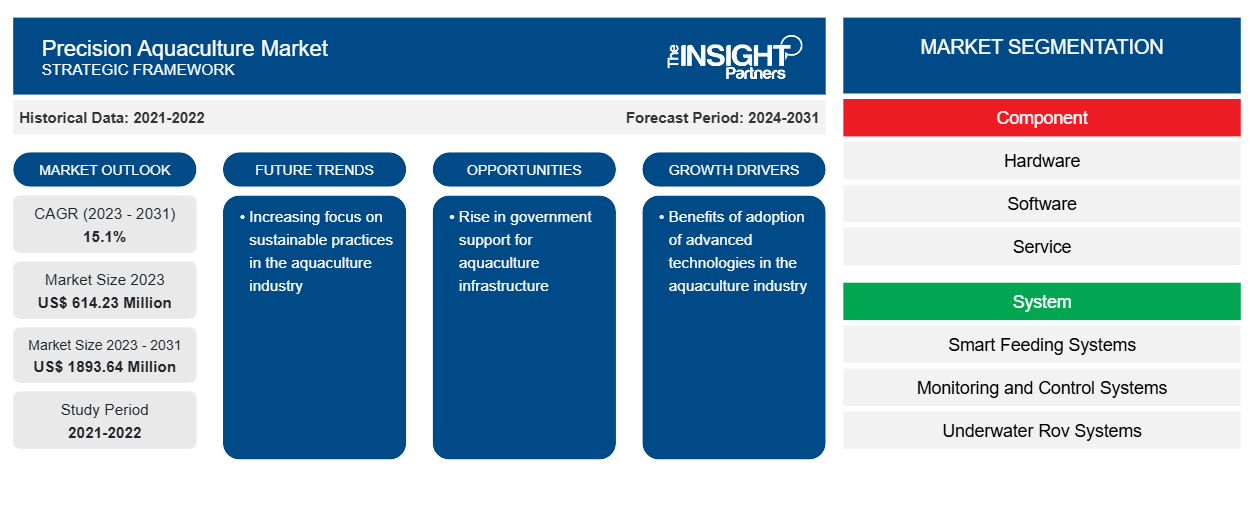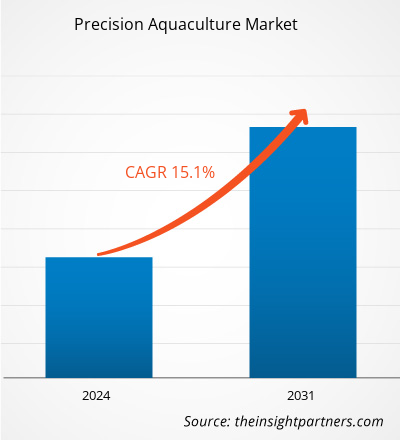The precision aquaculture market size is projected to reach US$ 1893.64 million by 2031 from US$ 614.23 million in 2023. The market is expected to register a CAGR of 15.1% during 2023–2031. The rise in investment for the aquaculture infrastructure and surging adoption of IoT solutions in the aquaculture industry are likely to remain key trends in the market.
Precision Aquaculture Market Analysis
The rise in the adoption of AI, IoT, and ROV in aquaculture farming is one of the major factors driving the growth of the market. The growing government focus and investment towards the development of aquaculture infrastructure fuelling the market growth. The contribution of precision aquaculture techniques towards sustainable seafood production and cater to the global demand for aquatic products further fuels the market growth.
Precision Aquaculture Market Overview
The aquaculture industry is widely experiencing the deployment of Internet of Things (IoT) devices to modernize their farm and make data-driven decisions. Precision aquaculture uses interconnected sensors and software in the marine environment to monitor, analyze, interpret, and provide decision support for aqua-farm operations. The data-based aquaculture system helps the operators in the aqua industry to increase productivity.
Customize This Report To Suit Your Requirement
You will get customization on any report - free of charge - including parts of this report, or country-level analysis, Excel Data pack, as well as avail great offers and discounts for start-ups & universities
Precision Aquaculture Market: Strategic Insights

-
Get Top Key Market Trends of this report.This FREE sample will include data analysis, ranging from market trends to estimates and forecasts.
Precision Aquaculture Market Drivers and Opportunities
Benefits of Adoption of Advanced Technologies in the Aquaculture Industry to Favor the Market
The aquaculture industry experiences challenges such as increasing feed and energy costs, environmental threats, production inefficiencies, and others. To overcome these challenges, the industry is using sensors, cameras, artificial intelligence, cloud technologies, and several other solutions to carry out unprecedented insights based on the data, which leads to growth in the precision aquaculture market. In addition, the market players are providing solutions to the aquaculture industry market players. For example, Innovasea’s precision aquaculture technologies help aquaculture operators to closely monitor, manage and control their operations based on reliable real-time data. It helps the operators with better decision-making to boost profits and become more sustainable.
Rise In Government Support For Aquaculture Infrastructure
The increasing trend of smart fishing and growth in the seafood trade is magnifying the demand for products required for the development of aquaculture infrastructure. Changes in the food consumption pattern worldwide are also contributing to the expansion and diversification of this industry. Besides, the growth of the retail industry and the easy availability of aquaculture products through numerous channels propel the sales of these products. The vigorous and continuous growth of aquaculture in various prominent countries, such as Norway, China, India, and Indonesia, is driving the global precision aquaculture market.
Precision Aquaculture Market Report Segmentation Analysis
Key segments that contributed to the derivation of the precision aquaculture market analysis are component, system, and application.
- Based on the component, the precision aquaculture market is divided into hardware, software, and service. The hardware segment held the largest share of the market in 2023.
- By system, the market is segmented into smart feeding systems, monitoring, and control systems, underwater Rov systems, and others. The smart feeding systems held a significant share of the market in 2023.
- By application, the market is segmented into fraud detection & prevention, governance risk & compliance (GRC), customer experience management, predictive maintenance, supply chain management, threat intelligence, and others. The customer experience management held a significant share of the market in 2023.
Precision Aquaculture Market Share Analysis by Geography
The geographic scope of the precision aquaculture market report is mainly divided into five regions: North America, Asia Pacific, Europe, Middle East & Africa, and South & Central America.
Europe is expected to hold a significant CAGR in the forecast period. The rise in digitalization and growing demand for advanced data analytics techniques in the region is driving market growth. In addition, the government fund to fuel the aquaculture industry drives the market. For example, the EU Horizon 2020 Fund aimed at sustainable aquaculture intensification in Europe. The GAIN project funded by the EU Horizon 2020 Fund is focused on precision aquaculture.
Precision Aquaculture Market Regional Insights
The regional trends and factors influencing the Precision Aquaculture Market throughout the forecast period have been thoroughly explained by the analysts at The Insight Partners. This section also discusses Precision Aquaculture Market segments and geography across North America, Europe, Asia Pacific, Middle East and Africa, and South and Central America.
Precision Aquaculture Market Report Scope
| Report Attribute | Details |
|---|---|
| Market size in 2023 | US$ 614.23 Million |
| Market Size by 2031 | US$ 1893.64 Million |
| Global CAGR (2023 - 2031) | 15.1% |
| Historical Data | 2021-2022 |
| Forecast period | 2024-2031 |
| Segments Covered |
By Component
|
| Regions and Countries Covered |
North America
|
| Market leaders and key company profiles |
|
Precision Aquaculture Market Players Density: Understanding Its Impact on Business Dynamics
The Precision Aquaculture Market is growing rapidly, driven by increasing end-user demand due to factors such as evolving consumer preferences, technological advancements, and greater awareness of the product's benefits. As demand rises, businesses are expanding their offerings, innovating to meet consumer needs, and capitalizing on emerging trends, which further fuels market growth.

- Get the Precision Aquaculture Market top key players overview
Precision Aquaculture Market News and Recent Developments
The precision aquaculture market is evaluated by gathering qualitative and quantitative data post primary and secondary research, which includes important corporate publications, association data, and databases. A few of the developments in the precision aquaculture market are listed below:
- Innovasea, a global leader in technologically advanced aquatic solutions for aquaculture and fish tracking, announced that it is now offering land-based aquaculture solutions to the Chilean aquaculture industry. (Source: Innovasea, Press Release, April 2024)
- Skretting Southern Europe launched 360+, the disruptive precision farming concept that optimizes feeding protocols and production management, further increasing Mediterranean aquaculture’s competitiveness. Utilizing the latest analytical software and other Industry 4.0 technologies to bring greater levels of innovation to fish production, Skretting 360+ is a complete package of precision-based tools and services, incorporating nutrition, farm management practices and technical support as well as state-of-the-art underwater cameras and sensor equipment (IoT). (Source: Skretting, Press Release, April 2023)
Precision Aquaculture Market Report Coverage and Deliverables
The “Precision Aquaculture Market Size and Forecast (2021–2031)” report provides a detailed analysis of the market covering below areas:
- precision aquaculture market size and forecast at global, regional, and country levels for all the key market segments covered under the scope
- precision aquaculture market trends as well as market dynamics such as drivers, restraints, and key opportunities
- Detailed PEST/Porter’s Five Forces and SWOT analysis
- precision aquaculture market analysis covering key market trends, global and regional framework, major players, regulations, and recent market developments
- Industry landscape and competition analysis covering market concentration, heat map analysis, prominent players, and recent developments for the precision aquaculture market
- Detailed company profiles
Frequently Asked Questions
What would be the estimated value of the precision aquaculture market by 2031?
Which are the leading players operating in the precision aquaculture market?
What is the future trend of the precision aquaculture market?
What are the driving factors impacting the precision aquaculture market?
What is the expected CAGR of the precision aquaculture market?
- Historical Analysis (2 Years), Base Year, Forecast (7 Years) with CAGR
- PEST and SWOT Analysis
- Market Size Value / Volume - Global, Regional, Country
- Industry and Competitive Landscape
- Excel Dataset
Recent Reports
Testimonials
Reason to Buy
- Informed Decision-Making
- Understanding Market Dynamics
- Competitive Analysis
- Identifying Emerging Markets
- Customer Insights
- Market Forecasts
- Risk Mitigation
- Boosting Operational Efficiency
- Strategic Planning
- Investment Justification
- Tracking Industry Innovations
- Aligning with Regulatory Trends





















 Get Free Sample For
Get Free Sample For